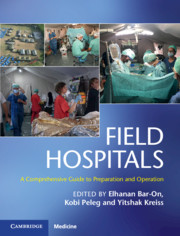Book contents
- Field Hospitals
- Field Hospitals
- Copyright page
- Contents
- Contributors
- Preface
- Section 1 History
- Section 2 Scenarios
- Section 3 Operational Considerations
- Chapter 6 Training and Accreditation
- Chapter 7 Personnel
- Chapter 8 Leading the Mission
- Chapter 9 Coordination and Organization of Medical Relief to Affected Areas
- Chapter 10 Field Hospital Logistics
- Chapter 11 Auxiliary Medical Services in a Field Hospital
- Chapter 12 Information and Communication Technologies in a Field Hospital
- Section 4 Clinical Considerations
- Section 5 Additional Contextual Considerations
- Index
- Plate Section (PDF Only)
- References
Chapter 9 - Coordination and Organization of Medical Relief to Affected Areas
from Section 3 - Operational Considerations
Published online by Cambridge University Press: 09 January 2020
- Field Hospitals
- Field Hospitals
- Copyright page
- Contents
- Contributors
- Preface
- Section 1 History
- Section 2 Scenarios
- Section 3 Operational Considerations
- Chapter 6 Training and Accreditation
- Chapter 7 Personnel
- Chapter 8 Leading the Mission
- Chapter 9 Coordination and Organization of Medical Relief to Affected Areas
- Chapter 10 Field Hospital Logistics
- Chapter 11 Auxiliary Medical Services in a Field Hospital
- Chapter 12 Information and Communication Technologies in a Field Hospital
- Section 4 Clinical Considerations
- Section 5 Additional Contextual Considerations
- Index
- Plate Section (PDF Only)
- References
Summary
Providing humanitarian relief to affected populations is a top priority following a major sudden onset disaster (SOD). The main form of medical relief to affected areas is the emergency medical teams (EMTs). These are groups of health professionals and support staff operating locally or outside their country of origin by providing healthcare to disaster-affected populations. Despite best intentions, for decades EMTs were disorganized and followed no clear standards. In the aftermath of the 2010 Haiti earthquake, the EMT Working Group of the World Health Organization‘s global health cluster initiated a global effort to standardize the EMTs system. This new system was put to the test in 2013 with the deployment of medical aid to the Philippines following Typhon Haiyan, and later on during the Ebola outbreak in West Africa and the earthquake in Nepal in 2015. This chapter reviews the history of medical aid to disaster affected areas, the process of coordinating and standardizing EMTs and the latest implementation of the new EMT coordination system.
Keywords
- Type
- Chapter
- Information
- Field HospitalsA Comprehensive Guide to Preparation and Operation, pp. 68 - 79Publisher: Cambridge University PressPrint publication year: 2020



